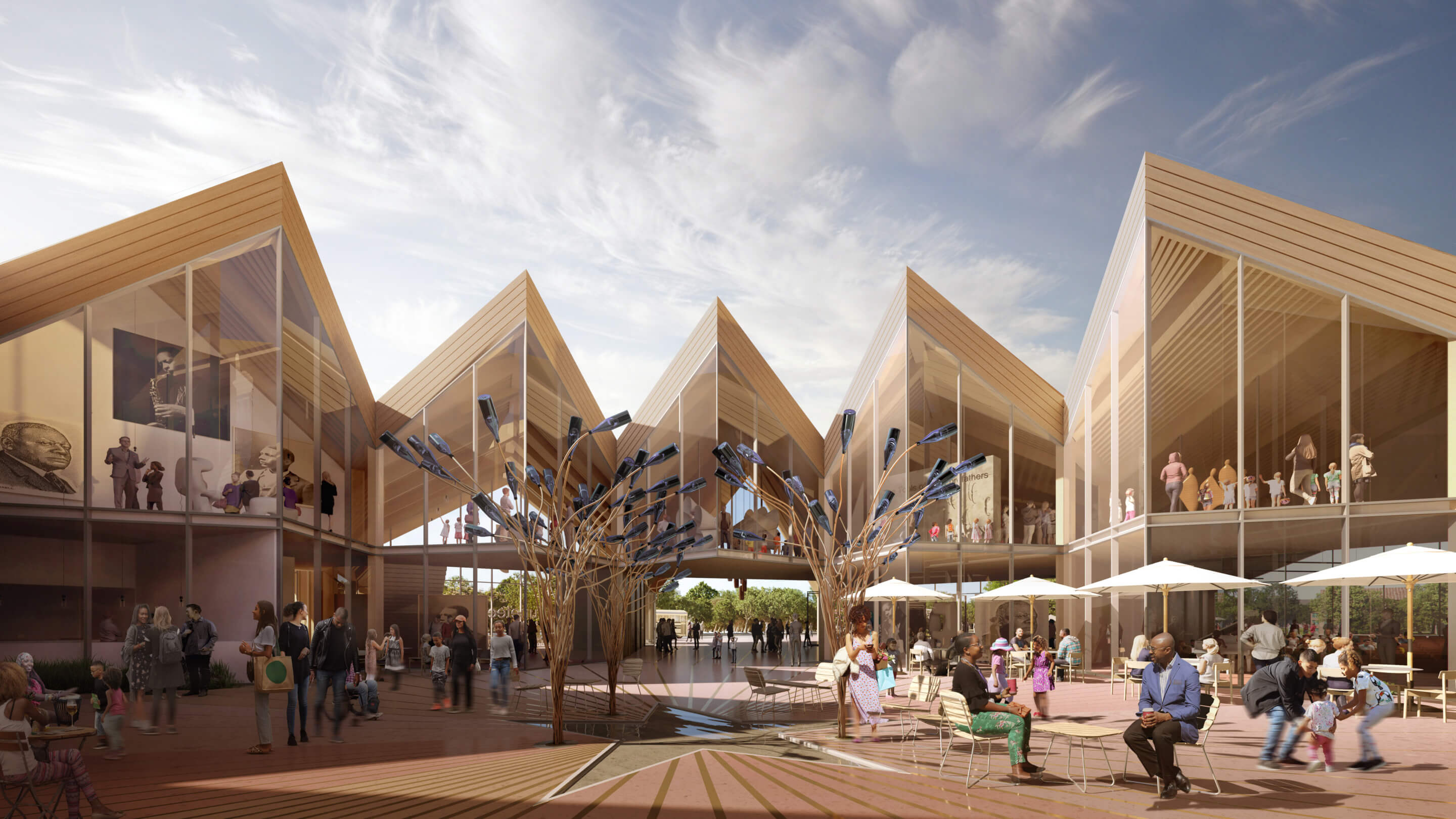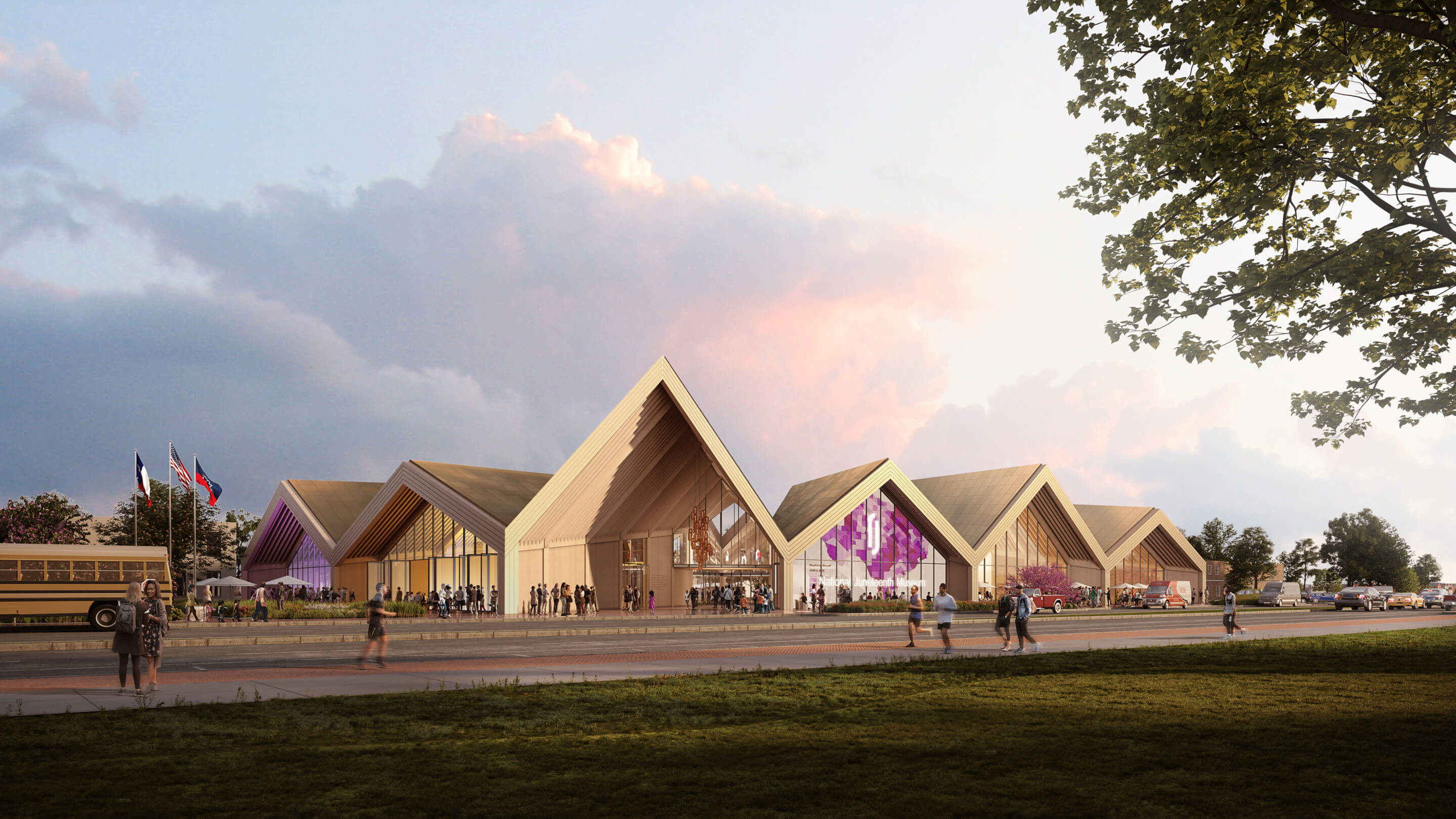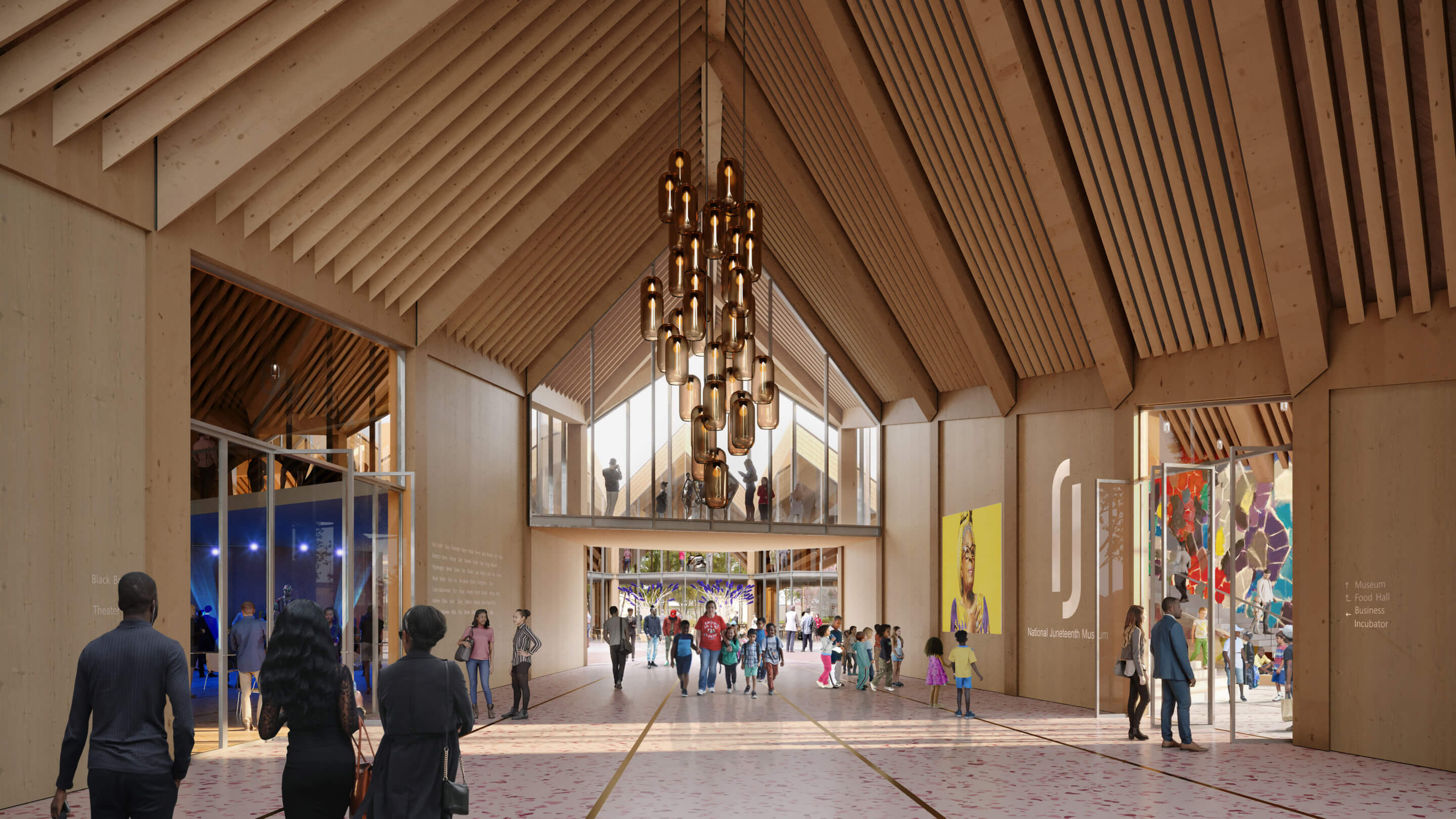The National Juneteenth Museum, a project first formally announced last October but envisioned by 95-year-old activist, educator, and 2022 Nobel Peace Prize nominee Opal Lee for far much longer, is forging ahead with plans to build a 50,000-square-foot facility that will anchor a larger mixed-use development on the Historic Southside of Fort Worth, Texas.
Late last week, local Fort Worth media shared initial design renderings of the planned museum along with news of an anticipated groundbreaking by the end of this year. If the current schedule holds, the institution will open its doors on or just ahead of 2024’s Juneteenth celebrations. Yesterday, on Juneteenth proper, the New York Times followed suit with a feature on the future museum, a timber building that’s gable-roofed form extends a generous nod to the homes of the surrounding neighborhood. The design is by Bjarke Ingels Group (BIG) with Douglass Alligood serving as partner in charge on the estimated $70 million project. “As a Black architect, this project is one of the most rewarding experiences of my career,” said Alligood in a museum press release.
The Dallas–Fort Worth office of KAI Enterprises, one of the largest minority-owned AEC firms in the country, is architect of record.

The National Juneteenth Museum isn’t technically the first museum in the city dedicated to the historic events of June 19, 1865, when Union Army general Gordon Grander arrived at the port of Galveston with word of General Order No. 3—a proclamation that effectively liberated an estimated 250,000 enslaved people in Texas more than two years after President Abraham Lincoln signed the Emancipation Proclamation. (A law-enacted state holiday in Texas since 1980, Juneteenth was adopted as a federal holiday last year and is the first new federal holiday since Martin Luther King, Jr. Day was designated in 1983.)
For nearly two decades, Lee, a longtime Fort Worth resident affectionately known as the “Grandmother of Juneteenth” due to her tireless campaigning to establish the long-running annual observance as a federal holiday, has operated a small and largely Texas-focused Juneteenth museum along Rosedale Street in the Historic Southside. (It served as a shooting location for the 2020 film, Miss Juneteenth.) But just as Juneteenth—a celebration of freedom and, more broadly, African American life and culture—has grown and evolved into a federally recognized holiday, Lee and her family believe that the museum should expand its scope as well. Lee’s granddaughter, Dione Sims, will serve as the new museum’s founding executive director.

“Seeing the national museum moving forward is a dream fulfilled,” said Lee, a founding board member of the museum who also serves on the board of Fort Worth’s Transform 1012 project, in a statement shared by the Fort Worth Star-Telegram.
“I’ve had a little Juneteenth Museum in that very spot for almost 20 years, and to see it become a central place for discussion, collaboration and learning seems to be the providential next step — from my walking campaign to Washington, D.C., the petition, and having Juneteenth declared a federal holiday,” she added. “It’s mind-boggling, but I’m glad to see it all come to pass.”
Like its predecessor, the new and considerably larger museum—envisioned as an “epicenter for education, preservation, and celebration of Juneteenth nationally and globally”—will include dedicated space for exhibitions and educational programming and be joined by a food hall showcasing local purveyors, a business incubator supporting Black entrepreneurs, a recording studio where museum-goers can document their own unique histories, and a 250-seat theatre for larger events. The museum’s design is oriented around a central courtyard with a five-point star engraved in gold that represents both Texas, which was the final state to free enslaved people, and the freedom of African Americans across all 50 states. Per CBS News, plans for a permanent exhibit will be dedicated to the “12 Freedoms” gained by previously enslaved people beginning in 1865 through 1945.
“Our hope is that this building will become a gateway to the Historic Southside community of Fort Worth while serving as a national and global destination,” said Alligood in the release. “Juneteenth is not only American history — it is world history.”
The museum hopes to offer free admission once the new facility opens.

Notably, the museum-anchored Rosedale Street site will also include residential units as part of a “mixed-use development that will help revitalize the city’s Historic Southside neighborhood,” according to the press announcement. Fort Worth-based PR and marketing firm Sable Brands is the project developer.
Like so many other thriving Black neighborhoods across the nation, the Historic Southside of Fort Worth was cleaved by a mid-century highway building project (I-35-W in this instance) that led to an extended period of disinvestment and economic decline from which the community has struggled to rebound from.
“It’s a neighborhood like many across the country that has been the victim of flight and neglect,” Jarred Howard, an executive with Sable Brands, told the Times. “For the better part of the last 30 years or so, the neighborhood has been downtrodden and destitute. This development will be catalytic in the resurgence of its economic and cultural health.”
As for BIG’s involvement, the museum explained that the firm was “hired to create a building that captures the spirit of Juneteenth, expresses the historic gravity of the day both locally and globally, and celebrates the cultural heritage of the Historic Southside.”
“Our engagement with Ms. Opal Lee and members of the community, to really understand their needs, is what informed a lot of the design principles,” Alligood explained.
Per the Times, funding for the project has so far come from private donations from individuals, foundations, and corporations although museum leadership is also seeking governmental support. Last week, the museum was named as just one grantee of the The North Texas Community Foundation’s Fund to Advance Racial Equity.
AN will report back when more design details of the National Juneteenth Museum emerge and the project begins to take further shape.











